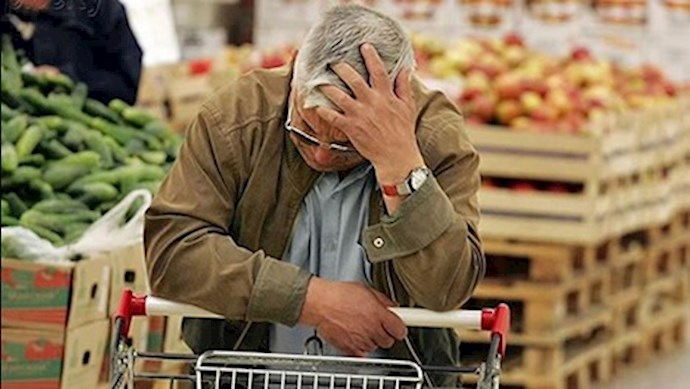Analysis by PMOI/MEK
Iran, July 26, 2021—In its latest report, the Statistics Center of Iran has concluded a more than 30 percent increase in household expenditures for the year 2020. As usual in previous years, the largest increase among food costs was related to bread, meat, and fruit, and among non-food items, housing had the largest share. Meanwhile, in the early months of the new calendar year (starting from March 21), inflation has increased again and according to the Statistics Center it currently stands at 43 percent, indicating the highest inflation rate in Iran in the last two decades.
Fruit is also removed from the families’ shopping basket
In a recent report from Iran food sales officials were asked about the fruit market situation. “The supply of fruit is not low, but there is no demand! Because many people do not have the power to buy summer fruits, and like protein and dairy products, Iranian families are gradually removing fruits from their shopping lists,” according to a June 29 report published by The Independent.
Rising prices for state-owned monopolies
The prices of goods that are actually produced and distributed by the government are also rising dramatically parallel to the skyrocketing prices of cars. Similar to quasi-state-owned enterprises that raise the prices of their products under any excuses, the most recent of which is the increase in prices of metals and cement under the pretext of power outages.
“One of the questionable events we are witnessing is the price of cement increasing by more than three-fold and the sudden rise in the price of metals. There is no logical reason for these increases … The traders took advantage of this opportunity and suddenly cement and metals became scarce like gold. These high prices have to a construction crisis in such a way that builders have stopped working until the prices of these return to being rational,” according to a July 20 report by the Tejarat daily.
The price of bread
Although many people in Iran have given up on buying or building a house and are resorting to living in rental houses, slums, or even sleeping on roof tops, putting at least some bread on the table is considered the bare minimum. However, many people in Iran nowadays can no longer afford to even purchase bread.
“In this regard, the head of the Tehran Chamber of Guilds officially announced the increasing price of bread. ‘The new prices of different types of bread were officially announced to the Chamber of Guilds by the governorate. On average, the price of bread has doubled, so it is not clear how the vulnerable classes or society will provide food for themselves’ he said,” according to a July 20 report [by the Tejarat daily.
Now, if we add the high price of milk and dairy products to the increasing price of bread, nothing else remains on the table for the lower class and even those previously considered among Iran’s now disappearing middle class.
What is the solution to alleviate these conditions? Kamran Nadri, an economist in Iran, acknowledges that the regime’s budgetary and extra-budgetary commitments are one of the most important factors in macroeconomic instability.
“Iran’s economy problems are usually unrelated to different governments. The existing problems are chronic and there is a strong inertia, and even the thinking that governs the economy tends to persist. Therefore, based on what has happened in the past, governments just come and go and cannot make a difference. As a result, we can conclude that this instability, especially in prices and chronic inflation in the Iranian economy, is likely to continue. I think in the future, given the current situation, we will follow down the same path,” according to a July 19 piece published by the state-run Tejarat-e Farda daily.
Corrupt networks
The fact that regime officials also acknowledge is that mafia-style groups dominate Iran’s economy and vital sectors.
“Mr. Raisi! What you receive is not a government, but a large economic enterprise that plays a role in economic interactions such as increasing the exchange rate or currency depreciation,” a member of the regime’s Majlis (parliament) said recently to the mullahs’ incoming president Ebrahim Raisi in this regard. “How can such a corrupt and rent-seeking structure serve the country? This structure bears no similarity to a servant state. The issue is not about paying ransom to the mafia that brought these disasters to the people. Tribal-style and rent-seeking management resulting from the national budget relying on oil has left a legacy that if you do not change it, you can be sure that it will swallow and transform pure objectives altogether,” the Majlis members added, according to a July 21 piece published in the state-run Eskenas daily.
Hossein Raghfar, a government-linked economist, says the main problem with the economy is lies, and not the United States and sanctions. “Strange incomes have entered the pockets of private-state enterprises that are not willing to lose those huge financial resources. This year, 6,000 trillion rials (about $24 billion) of rent has gone to the pockets of the owners of steel, petrochemical, and mining industries. Unfortunately, mafia-style networks in the economy pursue certain interests and therefore do not allow any change,” according to a July 21 piece wired by the Fars news agency, an outlet linked to the regime’s Revolutionary Guards (IRGC).
What effective measure can the country with the world’s sixth highest inflation rate, reached 50 percent now, take under the presidency of Ebrahim Raisi, an individual who specializes in genocide, imprisonment, and torture?
“People are stuck in a crisis of high prices and are waiting for things to improve. However, economic realities show that nothing special will occur. Just one mullah is leaving office, to be replaced with another,” according to a July 20 report in the state-run Tejarat daily.





